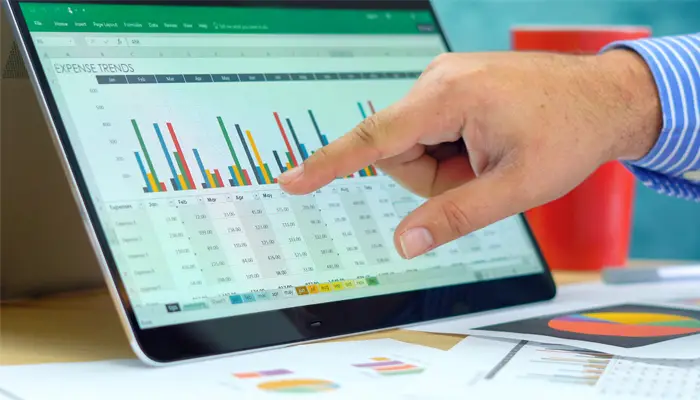In today’s data-driven world, Microsoft Excel has become an essential tool for professionals across various industries. Mastery of Excel can open doors to new career opportunities and improve your efficiency in handling complex data sets.
As a result, it’s no surprise that Excel proficiency is a highly sought-after skill by employers, and being well-prepared for Excel interview questions can give you a competitive edge in the job market.
In this article, we’ll explore some of the most common and challenging Excel interview questions you may encounter.
Whether you’re an aspiring analyst, a seasoned finance professional, or just looking to brush up on your Excel skills, this list of Excel interview questions will help you confidently showcase your expertise and stand out in your next interview.
35 Excel Interview Questions
These will feature beginner, intermediate, and advanced Excel interview questions.
- Can you explain the difference between a relative, absolute, and mixed cell reference?
- What is the purpose of using formulas and functions in Excel? Can you provide some examples of commonly used functions?
- How do you apply conditional formatting to a range of cells? Provide an example scenario where this would be useful.
- Explain the difference between VLOOKUP and HLOOKUP. When would you use each one?
- What is a pivot table and how can it be used to analyze data in Excel?
- Can you explain the process of creating a chart or graph in Excel? What types of charts are available?
- What is data validation and how can it be used to improve data accuracy in a spreadsheet?
- Describe the use of filters and sorting in Excel. How can these features help you manage large datasets?
- How do you combine data from multiple sheets or workbooks into a single sheet?
- What are Excel macros and how can they be used to automate repetitive tasks?
- Explain the difference between CONCATENATE and TEXTJOIN functions. Provide examples of when you might use each.
- What is the IF function and how can it be used in decision-making scenarios within a spreadsheet?
- How do you handle large datasets in Excel? Provide some tips for optimizing performance and managing resources.
- What is the purpose of using named ranges in Excel? How do you create and manage them?
- Describe the use of the Data Model feature in Excel. How does it help with data analysis?
- Can you explain the concept of array formulas in Excel? Provide an example of when you might use one.
- What are your favourite keyboard shortcuts in Excel? How do they improve your efficiency when working with spreadsheets?
- What is the difference between COUNT, COUNTA, and COUNTIF functions in Excel? Provide examples of when you might use each.
- How do you create and format a table in Excel? What are the benefits of using tables instead of standard cell ranges?
- Explain the concept of Goal Seek in Excel and provide an example of how it can be used to solve a problem.
- What is Microsoft Power Query, and how does it integrate with Excel for data analysis purposes?
- How do you use the SUMIFS, COUNTIFS, and AVERAGEIFS functions in Excel? Provide examples of their use cases.
- Describe the process of creating and modifying a custom number format in Excel.
- What is the purpose of using sparklines in Excel? How do you create and customize them?
- How do you use the INDIRECT function in Excel? Provide an example of a situation where it might be useful.
- Explain the concept of conditional formatting with icon sets. How can they help visualize data in a spreadsheet?
- What is the OFFSET function, and how can it be used in Excel? Provide an example of its usage.
- How do you use the Find and Replace feature in Excel? What are some tips for using it effectively?
- What are slicers in Excel, and how can they be used to filter data in pivot tables and charts?
- Describe the process of inserting and modifying images, shapes, and SmartArt in Excel.
- What is the purpose of using the PMT function in Excel? Provide an example scenario where it would be useful.
- How do you use the EDATE and EOMONTH functions to work with dates in Excel?
- Explain the concept of circular references in Excel. How can they be identified and resolved?
- What is the difference between a one-variable and a two-variable data table in Excel? Provide examples of when you might use each.
- Describe the process of sharing and collaborating on an Excel workbook with multiple users. What are some best practices for effective collaboration?
8 Excel Job Interview Tips
Now that you have some sample questions to work with, here are some top tips you can use to ensure you make a good impression at your next interview.
- Take Excel courses: Enrol in online or in-person Excel courses to expand your knowledge and stay up-to-date with the latest features. These courses will not only help you learn new functions and techniques but also provide you with a certificate that can boost your resume.
- Practice regularly: The more you use Excel, the more comfortable you’ll become with its features and functionalities. Make it a habit to practice regularly by working on personal projects or finding sample datasets to analyze.
- Master key functions and formulas: Ensure that you have a strong understanding of essential functions and formulas in Excel, such as VLOOKUP, INDEX-MATCH, pivot tables, and conditional formatting. Be prepared to discuss their use cases and how they can solve specific problems.
- Know your shortcuts: Excel keyboard shortcuts can significantly improve your efficiency and speed while working with spreadsheets. Memorize the most useful shortcuts, and be prepared to demonstrate them during the interview.
- Prepare examples: Think of real-life scenarios where you’ve used Excel to solve problems or make decisions. Be ready to share these examples, highlighting the techniques and functions you used.
- Demonstrate data visualization skills: Excel offers various chart and graph options for data visualization. Familiarize yourself with these tools and be prepared to create visually appealing and informative charts during the interview.
- Brush up on Excel add-ins: Excel offers numerous add-ins and integrations (e.g., Power Query, Power Pivot) that can enhance its capabilities. Learn about these add-ins and be prepared to discuss their applications and benefits.
- Practice with mock interviews: Ask a friend or family member to conduct a mock interview with you, focusing on similar Excel questions as the ones above. This will help you become more comfortable discussing your skills and experience while also identifying areas where you may need to improve.
Wrapping up
There you have it, 35 Excel interview questions you can use to prepare yourself for your next job interview.
Remember that practice makes perfect, so continue to work on your skills and stay updated with the latest features and advancements in Excel.
With confidence and preparation, you’ll be well-equipped to excel in any data-driven role and take your career to new heights.








Leave a Comment